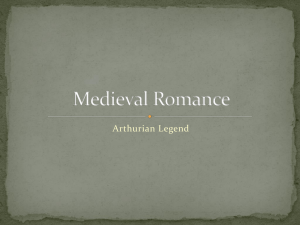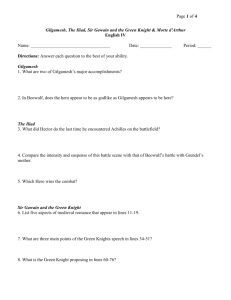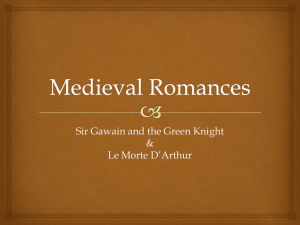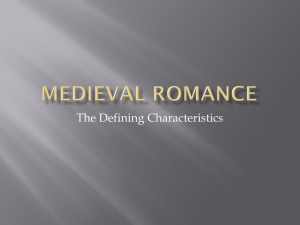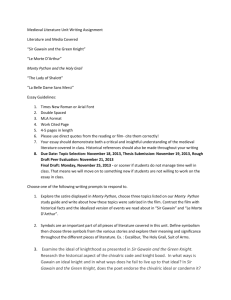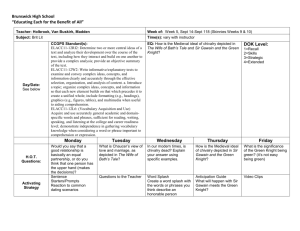Monty Python & the Holy Grail: Chivalry Satire Worksheet
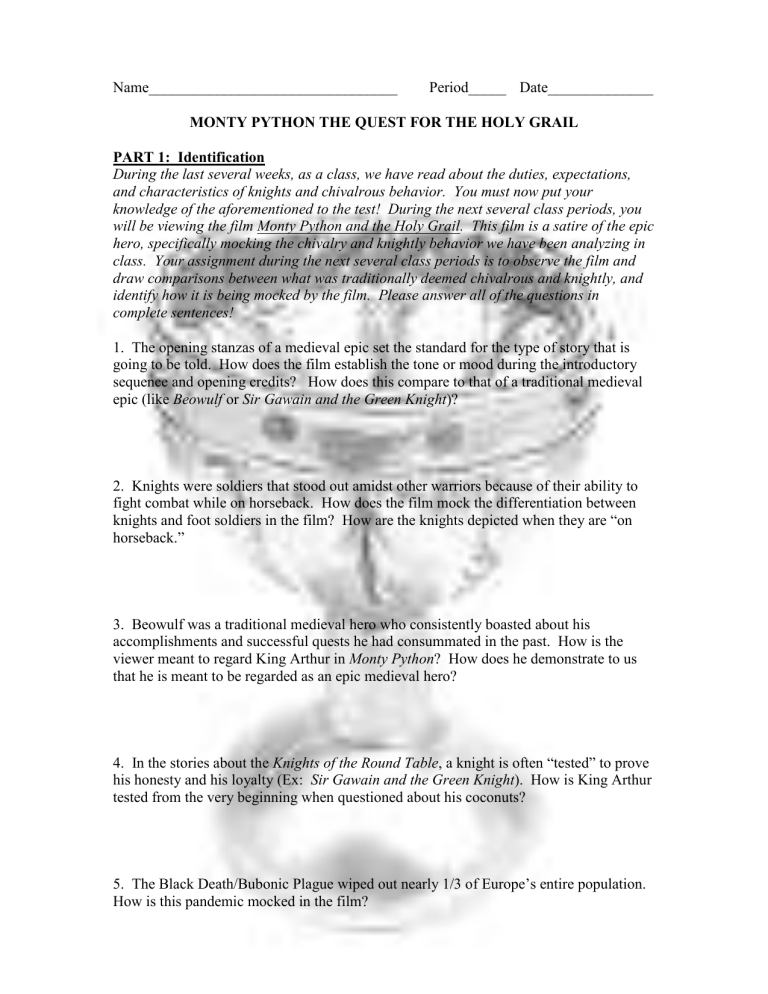
Name_________________________________ Period_____ Date______________
MONTY PYTHON THE QUEST FOR THE HOLY GRAIL
PART 1: Identification
During the last several weeks, as a class, we have read about the duties, expectations, and characteristics of knights and chivalrous behavior. You must now put your knowledge of the aforementioned to the test! During the next several class periods, you will be viewing the film Monty Python and the Holy Grail. This film is a satire of the epic hero, specifically mocking the chivalry and knightly behavior we have been analyzing in class. Your assignment during the next several class periods is to observe the film and draw comparisons between what was traditionally deemed chivalrous and knightly, and identify how it is being mocked by the film. Please answer all of the questions in complete sentences!
1. The opening stanzas of a medieval epic set the standard for the type of story that is going to be told. How does the film establish the tone or mood during the introductory sequence and opening credits? How does this compare to that of a traditional medieval epic (like Beowulf or Sir Gawain and the Green Knight )?
2. Knights were soldiers that stood out amidst other warriors because of their ability to fight combat while on horseback. How does the film mock the differentiation between knights and foot soldiers in the film? How are the knights depicted when they are “on horseback.”
3. Beowulf was a traditional medieval hero who consistently boasted about his accomplishments and successful quests he had consummated in the past. How is the viewer meant to regard King Arthur in Monty Python ? How does he demonstrate to us that he is meant to be regarded as an epic medieval hero?
4. In the stories about the Knights of the Round Table , a knight is often “tested” to prove his honesty and his loyalty (Ex: Sir Gawain and the Green Knight ). How is King Arthur tested from the very beginning when questioned about his coconuts?
5. The Black Death/Bubonic Plague wiped out nearly 1/3 of Europe’s entire population.
How is this pandemic mocked in the film?
6. The plague was brought about due to the filthy and deplorable living conditions that existed during the 14 th
century. Where do we see how filth and refuse exhibited in the film? What are the people doing in the muck and grime that is indicative of the time period?
7. During the latter parts of the 13 th
and 14 th
century, the elderly lost some of their importance in the community and were becoming quite disrespected because of their lack of contribution to the fields and work. Provide one example from the film that shows how the elderly were poorly regarded?
8. The social hierarchy of medieval Europe was primarily that of a feudal system, where the king and the barons owned all of the land, and peasants had little or no right to associate with the aristocracy. In the film, describe the conversations that King Arthur has with the “political peasants.” What makes their conversation ironic ?
9. Peasants had little or no understanding of politics or even a simple education. How is the ignorance of the peasants mocked while King Arthur is touring the countryside?
10. Beowulf is able to establish his authority as a knight by literally fighting to his death.
Sir Gawain also literally puts his neck on the line in order to fulfill the contract he had set up with the Green Knight. In Monty Python , describe how does the Black Knight demonstrate this same ideology?
11. Ironically enough, who is the Black Knight fighting when King Arthur comes across him on his travels?
12. When analyzing Beowulf , we were able to make observations about the use of light vs. dark in the literature, using the characters and their settings. How do the color of the
Black Knight and the setting of their epic battle symbolize the theme of light vs. dark?
13. Among the many wounds that the Black Knight receives, one of them very closely resembles a “flesh wound” received by an antagonist that we have read about this year.
Which adversary, do you think, is being mocked? How do you know?
14. Flagellism was a 13 th
and 14 th
century radical Christian movement that featured religious followers painfully whipping their own backs with flails, and otherwise causing harm to punish themselves to make atonement for their daily sin (ex: Sir Gawain atoning for his sins through confession). How does the religious group in the film cause harm to their bodies in order to atone for their sins?
15. In order to prevent people from practicing pagan rituals associated with antiquated religions, priests and aristocrats routinely accused casually religious people of witchcraft in order to scare people into regular assimilated church services (ex: The Crucible ).
Describe the conversation that takes place with the religious official and the townspeople regarding the woman they are accusing of witchcraft. What is their reasoning for determining that she is a which? How are they able to determine that she is a witch?
16. Scops regularly performed in order to tell stories such as those associated with King
Arthur and the Knights of the Round Table. In order to convey their stories, they used dancing, singing, and musical performers. How is this ideology mocked when the viewer is introduced to the castle of Camelot?
17. God played a central role in the culture, and often people were made to feel inferior to the wills and power of God over men. How does King Arthur show homage to God when he makes an appearance in the clouds? What is God’s reaction to King Arthur’s wallowing?
18. As was previously mentioned, knights went on great divine quests in order to prove their honor and valor; their primary missions were for religious reasons such as the
Crusades and fulfillment of the chivalric code. What sort of religious quest does God ask of King Arthur and his Knights of the Round Table?
19. In order to show the importance of a great divine quest, usually there is vivid imagery associated with the mission almost directly after it is given. (For example: the description of Sir Gawain’s shield, horse, etc.). Describe the imagery that follows God’s quest to King Arthur? What kind of images does the viewer see, and what kind of significance does it show?
20. The English were taken over by the Normans during the 11 th
and 12 th
centuries and had a strong influence over the English during the 13 th
century, as well. Discuss the exchange between the French soldiers and the Knights of the Round Table. What are the
French doing that is indicative of their influence over the English during this time period?
21. The French are credited with introducing chivalry and kind mannerisms to the British during the middle ages. How is this ideology ironic when compared to how the English engage in conversation with the French when regarding the film?
22. Most people are familiar with the story of the Trojan Horse trick and how it turned the momentum of the war in favor of the Greeks. How is a similar depiction recreated in
Monty Python when the Knights of the Round Table are trying to enter the French castle?
23. As mentioned before, a scop was responsible for maintaining the stories about the history of the people. The scop was often accompanied by music, singing, dancing, etc.
How is the use of a “famous historian” used as a scop?
24. Speaking of scops, when the film shifts to the Tale of Sir Robin , describe the entourage that accompanies Sir Robin. How does this mock the storytelling when reflecting on the Tale of Sir Robin ?
25. A medieval epic tale usually features some supernatural aspect, whether it is monsters, dragons, or surviving a beheading. How do you think the use of a threeheaded-knight is indicative of a medieval epic?
26. As a class, we were able to identify one of the qualities of a knight is celibacy or chastity. Upon his visit to Castle Anthrax, how is the loyalty and respectability of Sir
Galahad the Chaste tested?
27. We discussed in class how women were traditionally depicted in medieval literature: seductive, sexually aggressive, and catering only to the needs of a man (Ex: Lady
Bertilak in Sir Gawain ). While visiting the Castle Anthrax, how is this idea replicated?
How does the director use satire to reveal the traditional responsibilities of young women in medieval literature?
28. Often times a knight will have to prove his worthiness and honor by partaking in a
“game within a quest.” (For example: in
Sir Gawain and the Green Knight , we see that
Sir Gawain must prove his respect for marriage and his own chastity by not engaging in inappropriateness with the Lady Bertilak). In the film, how is the design of a “game within a quest” presented to King Arthur upon his encounter with the Knights who say
“Ni?”
29. Of the most noble of quests were usually those that sought the freedom of a fair maiden from a tower of imprisonment. Describe the irony surrounding this idea regarding the letter that Sir Lancelot receives from an arrow. Who really sent the letter to
Sir Lancelot? How does this person fit the stereotype of a fair maiden imprisoned in a tower?
30. The son of the King who is imprisoned in the tower is engaged to a woman as part of an arranged marriage organized by his father. What is ironic about this “fair maiden” and the supposed arrangement?
31. Courtesy, hospitality, and politeness were staples of chivalry and knightly behavior.
How is Sir Lancelot’s entrance into the castle a stark contrast to what we expect of knightly behavior? What kinds of things does he do that would make a knight unworthy?
32. Sir Lancelot makes his way up to the tower to discover that his maiden is in fact a young boy seeking to be rescued. How does the film satire the stereotype? What is Sir
Lancelot’s reaction?
33. In the 14 th
century, the peasants, tired of being ruled under the feudal system of government, revolted against the king and his followers. Similarly, what happens to Sir
Lancelot and the King when they are walking down the stairs from the tower they just visited?
34. Many times in medieval epics, the completion of a quest means the immediate succession of another quest, or an amendment to the previous quest. (For example, in Sir
Gawain and the Green Knight , the reader knows that Sir Gawain gives the sash back in order to appease the Green Knight and note the error of his ways). In Monty Python , after Arthur returns with the shrubbery that he was required to provide to the Knights who say “Ni,” how does his quest change?
35. Prophecy and telling of futures is a regular part of medieval literature. Which character plays the role of a prophet, and how does it impact the quest for the Holy Grail?
36. In the tale of Beowulf , the dragon becomes agitated when a thief steals a cup from the treasure stockpiled in the cave. In the film, what cute little creature is helping to protect the path to the Holy Grail, which is in effect, the cup of Christ? What more elaborate, lizard like animal is also protecting the way?
37. The Danes, and eventually the Geats, are often depicted as being cowardly and not sticking around to fight in the most difficult of battles. Where do we see the Knights of the Round Table “running away?”
38. One of the main aspects of Christianity is the focus on the Holy Trinity (God the
Father, Jesus his son, and the Holy Spirit). Because of this the repetition of the number three in the Bible is symbolic. How is the number three characterized and emphasized during the reading of the rules associated with how to use the Holy Hand Grenade?
39. Beowulf ultimately has to defeat the dragon at the end of his tale in order to save the
Geats. What dragon-like animal do the Knights of the Round Table have to dispatch before they can continue their quest for the Holy Grail?
40. In Sir Gawain and the Green Knight , the Green Knight offers a challenge, an exchange of strokes across one’s neck. Initially, all of Arthur’s knights are apprehensive about accepting the challenge. How is the scene that leads up to the Bridge of the Dead similar to the exchange in King Arthur’s Court? Who finally accepts the challenge first?
41. Having smart wit and being able to outsmart the opponent is key in the success of any king or knight on a quest. In Monty Python , how do we see intelligence playing an intricate part in King Arthur’s ability to cross the Bridge of the Dead?
42. In the tale of Beowulf , we know that the protagonist has to cross over the seas to reach Denmark in order to slay the evil beast Grendel. Similarly, how does King Arthur come to arrive at the “Castle of Arghhhhh?” Describe his mode of transportation—is the architecture more reminiscent of the English Navy or a Norwegian Navy? How can you tell? (Hint: Think of where Beowulf hails from).
43. After the French soldiers taunt Arthur again, how is his reaction similar to that of the
Danes when regarding the story of Beowulf ?
44. Knights would often assemble to fight for a holy noble quest on behalf of
Christianity, and engage in battles known as Crusades. How is the final scene with the assembly of knights on the knoll similar to this idea?
Part 2: Essay
After carefully analyzing the film and answering all questions related to comparing and contrasting traditional medieval literature, please construct a 5-paragraph essay that discusses how the themes in medieval literature are mocked or satirized in the film.
Look through your answers carefully and see if you can identify any common themes among them. Also, see if there are any themes that repeat themselves over and over again. Once you are able to identify these themes, draw comparisons to how these themes are exemplified in the film when compared to how they are depicted in the medieval narratives that we have read in class ( Beowulf and Sir Gawain) ).
Themes Discussed in Medieval Literature:
Chivalric Code & Knightly Behavior
The Art of Courtly Love & Role/Responsibility of Women
Characteristics of a Noble Quest
Role of Religion
Good vs. Evil (including symbolic elements)
Please ensure that your essay has:
An introduction to set up the ideas you are going to analyze
Several body paragraphs to support your argument using evidence about how the above themes and motifs are satirized in the film: o The text ( Beowulf and/or Sir Gawain) , o The film ( Monty Python ), and o Your notes, handouts, notes, discussion, etc.
A conclusion summing up your ideas
